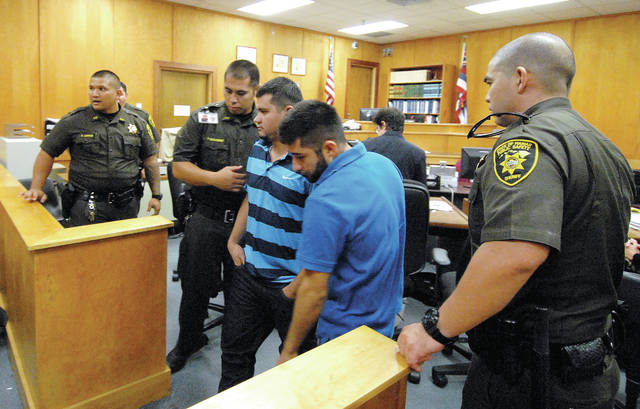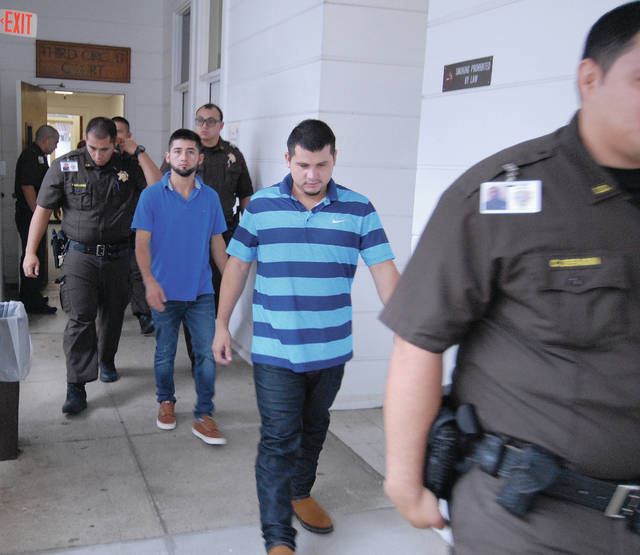New policy says suspects can appear in court without shackles
KAILUA-KONA — A recent federal court ruling allows criminal defendants who have not been proven guilty to appear in court without shackles, as the restraints go against their constitutional rights.
The Hawaii State Judiciary started adhering to the ruling, handed down by the 9th Circuit Court of Appeals, by implementing procedures that allow for the unshackling of pretrial status defendants in courtrooms.
Hawaii Island’s top prosecutor, however, feels the decision is troubling.
“We are concerned for the safety of the community, victims and those in court,” County Prosecutor Mitch Roth said. “We are also expecting that the court process will be greatly delayed.”
Pretrial status is any hearing before trial. That includes initial appearances, arraignments, motion hearings and preliminary hearings.
On Friday, at least three in-custody defendants were brought into the 3rd Circuit courtroom at the Kona courthouse in Kealakekua free of waist and wrist chains. They were still bound by ankle shackles.
The ankle shackles could also be removed as the judiciary is still working out the kinks of the new policy.
“Under the Fifth Amendment, no person shall be deprived of life, liberty, or property, without due process of law,” the 9th Circuit filing states. “A presumptively innocent defendant has the right to be treated with respect and dignity in a public courtroom, not like a bear on a chain.”
New rule at work in Kona
While the judiciary has been in the process of implementing the new procedures since July, the Kona District Court was first faced with the issue on Aug. 30 when a public defender requested her client, who is facing a murder charge, appear without chains and in plain clothes for his preliminary hearing.
After addressing public safety concerns with the Hawaii County Sheriff’s Office, District Court Judge Margaret Masunaga granted the request.
Public Defender Wendy DeWeese said she is for the unshackling. She does understand the safety concerns the sheriff’s deputies might have on the matter. However, with the media’s increased presence in courtrooms, DeWeese said, shackled defendants do present prejudicial issues.
“I don’t think it’s fair their pictures are plastered all over the TV or newspapers chained like animals,” DeWeese said of defendants. “(The unshackling) is consistent with the theory of innocent until proven guilty.”
The filing doesn’t address the issue of plain clothes, however employees at the courthouse spoke to the potential dangers of allowing such a request.
Lani Ng, court administrator for court operations in Kona, said if an in-custody defendant were to escape it would be harder to identify them because they could disappear into the general population. Wearing the jail outfits allows potential escapees to stand out more and be taken into custody more quickly.
The unshackling in Hawaii State courtrooms is being implemented statewide. Toni Schwartz, spokeswoman for the Department of Public Safety, said the department will follow the appeal and continue to work with the judiciary to make sure courtrooms are safe.
At this point, only in-custodies appearing in Circuit Court at the Kona courthouse are being unshackled. Eventually, deputies will roll out the policy into district court.
9th Circuit Court of Appeals ruling
The ruling handed down in the 9th Circuit Court of Appeals on May 31 clarifies that the Fifth Amendment right to be free of unwarranted restraints applies whether the proceeding is pretrial, trial or sentencing with or without a jury.
The ruling stems from a case in the Southern District Court of California where four defendants were denied appearing in court unshackled. The denial came after a district-wide policy requested by the U.S. Marshals Service in 2013 indicated all in-custody defendants appear in full restraints for most non-injury proceedings.
Starting the first day of the policy’s implementation, the ruling indicates that federal defenders of San Diego objected to the routine use of shackles and requested that each defendant’s shackles be removed.
“The judges routinely denied the requests, relying on the Marshals Service’s general security concerns as well as concerns particular to the Southern District,” the filing states.
The defendants cited in the ruling appealed the denials in district court and also filed emergency motions challenging the constitutionality of the district-wide policy.
The decision was overturned in the appeals court.
The filing states that a member of the public who wanders into a criminal courtroom must immediately perceive that it is a place where justice is administered in regard to those where the law presumes them innocent until proven guilty.
“That perception cannot prevail if the defendants are marched in like convicts on a chain gang,” according to the filing.
The ruling still allows the court to authorize shackling of defendants who pose a threat to the safety and security of those in the courtroom.
The ruling states “if the government seeks to shackle a defendant, it must first justify the infringement with specific security needs as to that particular defendant.”
“Because the sheriffs are responsible for transporting in-custody defendants to court, the sheriffs will directly inform the court if a particular defendant poses a security risk,” said Jan Kagehiro, director of Communications and Community Relations for the Hawaii State Judiciary. “Based on that information, the court will determine whether or not the defendant must be shackled.”
Kagehiro added that the procedures do not require a motion to be filed in order for a court to determine that a defendant must be shackled.
“However, this process is new and we cannot be certain that motions will or will not be filed in these matters in the future,” she said.
The Department of Justice has filed a petition with the U.S. Supreme Court seeking review of this ruling and the Hawaii State Judiciary will closely monitor this case.
Along with Hawaii, the 9th Circuit Court filing impacts California, Arizona, Nevada, Oregon, Idaho, Montana, Alaska as well as two U.S. territories Guam and Northern Mariana Islands.
The first case of unshackling in Kona
The first time unshackling was brought up in Kona was during a preliminary hearing on Aug. 30. Eber and Marlon Miranda-Garcia appeared in district court on a joint hearing facing murder and conspiracy charges.
Public Defender Terri L. Fujioka-Lilley filed a motion requesting her client, Eber Miranda-Garcia, appear for the hearing unshackled and in civilian clothes. She cited the 9th Circuit case as the reason her request should be granted. However, the filing doesn’t address anything about defendants appearing in plain clothes.
The brothers are facing charges in the death of Dolores “Lolo” Borja-Valle, who was found dead in a Captain Cook coffee field on Aug. 9, 2015.
DeWeese filed a joint motion requesting the same consideration be given to her client Marlon Miranda-Garcia.
According to the motion, filed on Aug. 27, Fujioka-Lilley states the court granted media motions for extended coverage — which means having a photographer in the courtroom to take pictures — over the defense objections on July 3 when the preliminary hearing commenced.
As a result, the motion states, a photograph of the defendant appeared in West Hawaii Today on July 4 handcuffed, shackled and in jail attire. The defendant was neither convicted nor had a finding of probable cause regarding charges been found.
Fujioka-Lilley asserts in the motion that such images are prejudicial to a defendant’s right to a fair and impartial jury.
Deputy Prosecutor Sheri Lawson filed a motion opposing the unshackling and plain clothes.
Lawson’s filing states Eber Miranda-Garcia is being held on a detainer by Ice Immigration Customs Enforcement and is currently charged with murder in the second degree.
“The state objects to the scope of the defendant’s request at this time as there has been no determination as to the dangerousness or risk of flight,” Lawson’s motion states.
After consulting with Lt. Patrick Kawai with the Department of Public Safety and a deputy in the courtroom about the potential safety and security concerns, Masunaga allowed the defense’s request.
A deputy in the courtroom that day described the request and the granting of said request as unprecedented.
Eber and Marlon Miranda-Garcia are scheduled to appear for jury trials in December.
Unique safety issues surrounding Kona courtrooms
But there are safety concerns paramount to Kona’s situation.
The Kona courthouse was the old Kona Community Hospital. One of the courtrooms was a nursery. The law library downstairs used to be part of the morgue. Because it was not built as a courthouse, Ng said the issue is it’s not a secured building.
“We do have issues with custodies going through public areas,” Ng said. “We’re doing our best to comply with the new policy.”
From what she can tell, Ng said, deputies are moving in-custodies in their restraints and removing the shackles right before they go into the courtroom.
Kagehiro stated in an email about 10 detainees come to the Kona courthouse from the jail every day, some of whom may be there for pretrial hearings.
There have been safety concerns at the courthouse in the past. Schwartz stated in an email the Department of Public Safety has record of three escapes from that facility. It is unknown if they were pretrial detainees.
In 2015, West Hawaii Today reported a shackled female detainee escaped from a holding area inside the courthouse. Deputies caught her a few minutes later in the parking lot.
Ng has worked at the courthouse in Kealakekua for several years. In her time, she said, there have been several attempted escapes by defendants who where both unshackled and shackled.
Since the implementation of the unshackling policy began, Ng said, court staff has been looking at ways to better secure the courthouse. There has been discussion of locking courtroom doors that lead to jurors and doing more video conferences from the jail to decrease the number of in-custodies brought to the building.
However, the staff still has to make sure they are abiding by fire safety codes by not locking exits. Ng added the video conference equipment is not working.
Ng and the court staff can’t wait until the new courthouse in downtown Kona opens in 2019 as she believes it will be better equipped to suit their needs.
The $90 million Kona Judiciary Complex is currently under construction. The 140,000-square-foot facility will have five courtrooms, a law library, self-help center, conference rooms, holding cells, witness rooms, attorney interview rooms and a grand jury meeting room.
“Two more years,” Ng said hopefully about the new courthouse.




